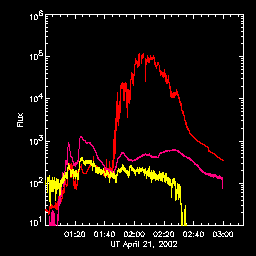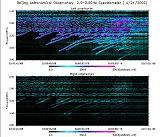
Complicated radio waves from an X-class flare

Many complicated things can be seen in this plot:

This represents a narrow range (1.2 GHz) of frequencies not far from the red line in the plot above), over a short time interval (about 3 minutes). It contains a myriad of drifting structures. Radio events with drifting fine structure occur, and in principle their occurrences tells us many things. Because of the frequencies we know that the sources of these emissions do not lie far up in the corona, but rather in the dense core of the flaring active region. So probably we would learn about flare dynamics directly if only we could understand them. But, this will require a new instrument: a Frequency Agile Solar Radiotelescope capable of true imaging spectroscopy, with high resolution in all parameters.
No conclusions, really, except to remind data analyzers of the great complexity of the radio spectrum of a solar flare. This complexity is unfortunate, but of course it points to complex knowledge that will be gained once the phenomena are understood.
May 10, 2002
Hugh Hudson and David McKenzie(hudson@isass1.solar.isas.ac.jp)